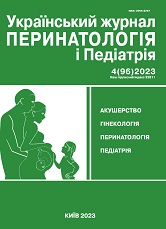Influence of smoking on immune response and susceptibility of women to sexually transmitted infections
DOI:
https://doi.org/10.15574/PP.2023.96.77Keywords:
cigarette smoking, women’s health, immune response, sexually transmitted infections, immunoglobulins, mucosal immunity, saliva composition, chronic inflammatory diseases, reproductive health, public healthAbstract
The study highlights the importance of understanding the impact of cigarette smoking on the immune system, especially in women. It sets the context for the study by discussing the increasing concern about how lifestyle factors like smoking can affect susceptibility to infections, particularly STIs.
Purpose - to explore how cigarette smoking affects the immune response in women and to investigate whether smoking increases the risk of contracting STIs. It seeks to identify specific immunological changes caused by smoking that could explain increased susceptibility to infections.
Materials and methods. The methodology involves a comprehensive analysis of saliva samples from 160 women. This group includes both smokers and non-smokers, with some having chronic inflammatory diseases due to STIs. The study measures levels of immunoglobulins and lysozyme-peptide in the saliva to assess changes in the immune response.
The results demonstrate significant alterations in immunoglobulin levels and lysozyme-peptide in the saliva of women who smoke, especially those with chronic inflammatory diseases caused by STIs. These findings indicate that smoking can modify local immunity and exacerbate the immune response to inflammatory processes associated with STIs.
Conclusions. The study concludes that cigarette smoking has a critical impact on women's reproductive health by altering their immune response and increasing their susceptibility to STIs. It underscores the need for greater attention to smoking as a major public health issue, emphasizing its role in women's health and the importance of incorporating smoking cessation strategies in disease prevention programs.
The study protocol was approved by the Local ethics committees of the institutions mentioned in the paper. An informed parental consent was obtained for the study in women.
No conflict of interests was declared by the authors.
References
Barbosa GF, Santos S. (2018, Feb). Effects of cigarette smoke on color change of resin composites. Am J Dent. 31(1): 3-6.
Budani MC, Tiboni GM. (2017, Sep). Ovotoxicity of cigarette smoke: A systematic review of the literature. Reprod Toxicol. 72: 164-181. https://doi.org/10.1016/j.reprotox.2017.06.184; PMid:28684319
Chen IL, Todd I, Fairclough LC. (2019, Sep). Immunological and pathological effects of electronic cigarettes. Basic Clin Pharmacol Toxicol. 125(3): 237-252. https://doi.org/10.1111/bcpt.13225; PMid:30861614
Dayan AD. (2016, Nov 30). Investigating a toxic risk (self-inflicted) the example of conventional and advanced studies of a novel Tobacco Heating System. Regul Toxicol Pharmacol. 81 (2): S15-S16. https://doi.org/10.1016/j.yrtph.2016.07.020; PMid:27483981
Gómez Cerezo JF, López Paz JE, Fernández Pardo J. (2022, Nov-Dec). Update on new forms of tobacco use. Clin Investig Arterioscler. 34(6): 330-338. Epub 2022 May 21. https://doi.org/10.1016/j.arteri.2022.03.004; PMid:35606216
Grill K. (2021, Jan 7). E-cigarettes: The Long-Term Liberal Perspective. Nicotine Tob Res. 23(1): 9-13. https://doi.org/10.1093/ntr/ntaa085; PMid:32453813 PMCid:PMC7789953
Grillo C, La Mantia I, Grillo CM, Ciprandi G, Ragusa M, Andaloro C. (2019, Jul 10). Influence of cigarette smoking on allergic rhinitis: a comparative study on smokers and non-smokers. Acta Biomed. 90(7-S): 45-51. doi: 10.23750/abm.v90i7-S.8658.
Heluany CS, Scharf P, Schneider AH, Donate PB, Dos Reis Pedreira Filho W, de Oliveira TF et al. (2022, Feb 25). Toxic mechanisms of cigarette smoke and heat-not-burn tobacco vapor inhalation on rheumatoid arthritis. Sci Total Environ. 809: 151097. https://doi.org/10.1016/j.scitotenv.2021.151097; PMid:34695477
Li Y, Hecht SS. (2022, Jul). Carcinogenic components of tobacco and tobacco smoke: A 2022 update. Food Chem Toxicol. 165: 113179. Epub 2022 May 25. https://doi.org/10.1016/j.fct.2022.113179; PMid:35643228 PMCid:PMC9616535
McAdam K, Eldridge A, Fearon IM, Liu C, Manson A, Murphy J, Porter A. (2016, Dec). Influence of cigarette circumference on smoke chemistry, biological activity, and smoking behaviour. Regul Toxicol Pharmacol. 82: 111-126. https://doi.org/10.1016/j.yrtph.2016.09.010; PMid:27634061
Savage NW, Barnard K, Shirlaw PJ, Rahman D, Mistry M, Escudier MP et al. (2004, Mar). Serum and salivary IgA antibody responses to Saccharomyces cerevisiae, Candida albicans and Streptococcus mutans in orofacial granulomatosis and Crohn's disease. Clin Exp Immunol. 135(3): 483-489. https://doi.org/10.1111/j.1365-2249.2004.02394.x; PMid:15008983 PMCid:PMC1808974
Sepand MR, Maghsoudi AS, Shadboorestan A, Mirnia K, Aghsami M, Raoufi M. (2021, Sep 15). Cigarette smoke-induced toxicity consequences of intracellular iron dysregulation and ferroptosis. Life Sci. 281: 119799. https://doi.org/10.1016/j.lfs.2021.119799; PMid:34229007
Solecki S, Adegite E, Turchi R. (2019, Oct). Clearing the air: adolescent smoking trends. Curr Opin Pediatr. 31(5): 670-674. https://doi.org/10.1097/MOP.0000000000000810; PMid:31389807
Soleimani F, Dobaradaran S, De-la-Torre GE, Schmidt TC, Saeedi R. (2022, Mar 20). Content of toxic components of cigarette, cigarette smoke vs cigarette butts: A comprehensive systematic review. Sci Total Environ. 813: 152667. https://doi.org/10.1016/j.scitotenv.2021.152667; PMid:34963586
Tam A, Filho FSL, Ra SW, Yang J, Leung JM, Churg A et al. (2020, Apr 6). Effects of sex and chronic cigarette smoke exposure on the mouse cecal microbiome. PLoS One. 15(4): e0230932. https://doi.org/10.1371/journal.pone.0230932; PMid:32251484 PMCid:PMC7135149
Downloads
Published
Issue
Section
License
Copyright (c) 2023 Ukrainian Journal of Perinatology and Pediatrics

This work is licensed under a Creative Commons Attribution-NonCommercial 4.0 International License.
The policy of the Journal “Ukrainian Journal of Perinatology and Pediatrics” is compatible with the vast majority of funders' of open access and self-archiving policies. The journal provides immediate open access route being convinced that everyone – not only scientists - can benefit from research results, and publishes articles exclusively under open access distribution, with a Creative Commons Attribution-Noncommercial 4.0 international license(СС BY-NC).
Authors transfer the copyright to the Journal “MODERN PEDIATRICS. UKRAINE” when the manuscript is accepted for publication. Authors declare that this manuscript has not been published nor is under simultaneous consideration for publication elsewhere. After publication, the articles become freely available on-line to the public.
Readers have the right to use, distribute, and reproduce articles in any medium, provided the articles and the journal are properly cited.
The use of published materials for commercial purposes is strongly prohibited.

